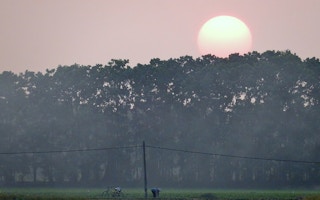What comes to mind when you think about climate change? The impact of fumes from all the traffic on your commute to work? Maybe erratic weather, with flooding in some places, severe drought in others?
Perhaps you also think about solutions to climate change and to the very real crisis it is creating. Because solutions, sometimes large and sometimes very small and very local, do exist.
Consider Duong Van Huynh and his forest farm in northeast Vietnam’s commune of My Phuong. He grows a variety of species of trees, which are all absorbing atmospheric carbon and storing it in their wood and in the soil. He also knows that by planting a mix of fruit trees, magnolia timber, and star anise spice trees, he is protecting the soil and conserving water on his sloping farmland.
How is that for down-to-earth climate-change mitigation? And Duong Van Huynh is not alone. Some 1.4 million other smallholder forest farmers across his country are taking similar measures and learning new techniques through affiliation with the 10 million member Viet Nam Farmers Union (VNFU).
Around the globe, there are about 1.5 billion smallholder forest and farm producers, many of them organised so they can better protect their rights and the productivity of their land - which very often includes managing and conserving forests. Like Duong Van Huynh, they see immediate benefits for their families as well as benefits for the global environment.
When trees absorb carbon dioxide - which is linked to climate change and all of the associated disastrous effects - they store that carbon; but when forests are destroyed, that carbon is re-released back into the environment, reversing previous gains. This means when forest and farm producers not only plant, but also conserve, protect and actively manage forests, they’re also playing a vital role in responding to climate change.
In this way, they are helping to meet some of the global Sustainable Development Goals (SDGs), including those dealing with climate change and sustainable ecosystems on land (SDGs 13 and 15). The collective might of producers is also addressing other SDGs. By finding new ways to keep their forests and farms viable, they’re fighting poverty and offering real livelihoods to their youth. That starts a virtuous cycle: more youth finding more work as forest and farm producers, which means more forests and farms, more valuable, productive trees, and ultimately, less climate change.
Miriam Andrea Cu-lcal, a Central American farmer in her twenties, has told us that support and training from her agroforestry co-operative federation FEDECOVERA has been important to improved productivity. And that has meant she can earn a living and plan her future around remaining on her farm.
What these smallholders need now is greater investment in their organisations so this work can not only continue, but expand. It’s simply common sense. Their lives and work puts these producers on the front lines of climate change and they, therefore, have the most to lose because of it. So who better to protect the land and forests?
In fact, worldwide a coalition of indigenous peoples and local communities is currently managing more than 400 million hectares of forests: for the good of their land, and to diversify incomes while helping the environment. How much more could they do with greater support?
“
Their lives and work puts these producers on the front lines of climate change and they, therefore, have the most to lose because of it. So who better to protect the land and forests?
Failure to invest in producer groups threatens this critical work. That’s why the Forest and Farm Facility (FFF), a partnership hosted by the UN Food and Agriculture Organization (FAO), strives to increase support to producer organisations. Already, FFF works in 10 countries to strengthen capacity and has supported 400 producer organisations that together boast 40 million members - and a commensurately huge potential for profound change.
Global climate efforts benefit from a better understanding of, and greater support for, the efforts by smallholder forest producers and their organisations to mitigate and adapt to climate change, according to a study published this week by FFF, the Finnish Agri-Agency for Food and Forest Development, and the Finnish Environment Institute.
What would result if these producer organisations could have greater influence with policy-makers? Perhaps if we answer these questions by providing the essential investments to make the most of this great potential, the world will meet many of the SDGs more quickly and better deal with the crisis of climate change.
Jeffrey Campbell is manager of the Forest and Farm Facility at FAO. This story was published with permission from Thomson Reuters Foundation, the charitable arm of Thomson Reuters, that covers humanitarian news, women’s rights, corruption and climate change. Visit news.trust.org.











